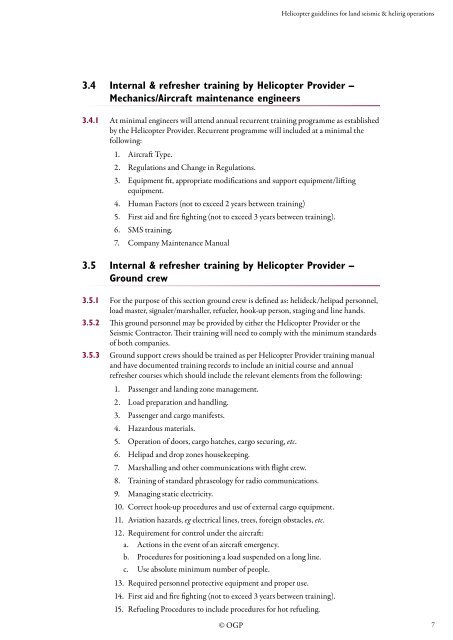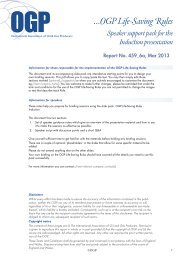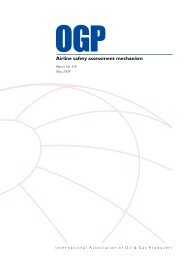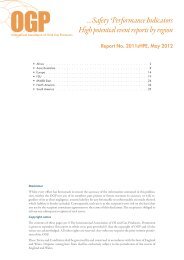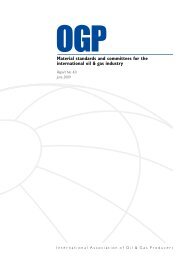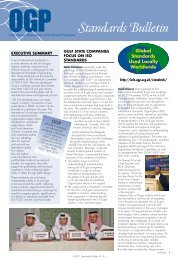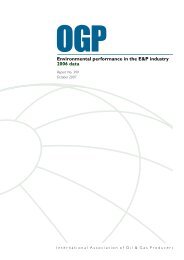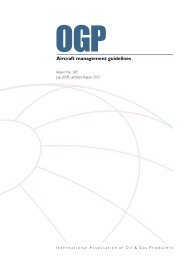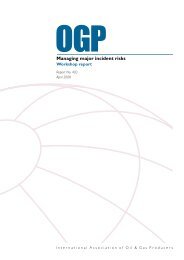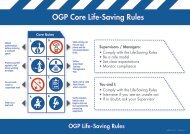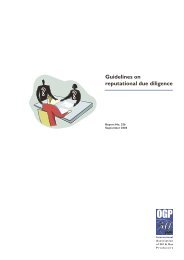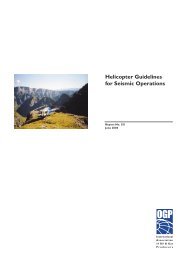Helicopter guidelines for land seismic & helirig operations - OGP
Helicopter guidelines for land seismic & helirig operations - OGP
Helicopter guidelines for land seismic & helirig operations - OGP
Create successful ePaper yourself
Turn your PDF publications into a flip-book with our unique Google optimized e-Paper software.
<strong>Helicopter</strong> <strong>guidelines</strong> <strong>for</strong> <strong>land</strong> <strong>seismic</strong> & <strong>helirig</strong> <strong>operations</strong><br />
3.4 Internal & refresher training by <strong>Helicopter</strong> Provider –<br />
Mechanics/Aircraft maintenance engineers<br />
3.4.1 At minimal engineers will attend annual recurrent training programme as established<br />
by the <strong>Helicopter</strong> Provider. Recurrent programme will included at a minimal the<br />
following:<br />
1. Aircraft Type.<br />
2. Regulations and Change in Regulations.<br />
3. Equipment fit, appropriate modifications and support equipment/lifting<br />
equipment.<br />
4. Human Factors (not to exceed 2 years between training)<br />
5. First aid and fire fighting (not to exceed 3 years between training).<br />
6. SMS training.<br />
7. Company Maintenance Manual<br />
3.5 Internal & refresher training by <strong>Helicopter</strong> Provider –<br />
Ground crew<br />
3.5.1 For the purpose of this section ground crew is defined as: helideck/helipad personnel,<br />
load master, signaler/marshaller, refueler, hook-up person, staging and line hands.<br />
3.5.2 This ground personnel may be provided by either the <strong>Helicopter</strong> Provider or the<br />
Seismic Contractor. Their training will need to comply with the minimum standards<br />
of both companies.<br />
3.5.3 Ground support crews should be trained as per <strong>Helicopter</strong> Provider training manual<br />
and have documented training records to include an initial course and annual<br />
refresher courses which should include the relevant elements from the following:<br />
1. Passenger and <strong>land</strong>ing zone management.<br />
2. Load preparation and handling.<br />
3. Passenger and cargo manifests.<br />
4. Hazardous materials.<br />
5. Operation of doors, cargo hatches, cargo securing, etc.<br />
6. Helipad and drop zones housekeeping.<br />
7. Marshalling and other communications with flight crew.<br />
8. Training of standard phraseology <strong>for</strong> radio communications.<br />
9. Managing static electricity.<br />
10. Correct hook-up procedures and use of external cargo equipment.<br />
11. Aviation hazards, eg electrical lines, trees, <strong>for</strong>eign obstacles, etc.<br />
12. Requirement <strong>for</strong> control under the aircraft:<br />
a. Actions in the event of an aircraft emergency.<br />
b. Procedures <strong>for</strong> positioning a load suspended on a long line.<br />
c. Use absolute minimum number of people.<br />
13. Required personnel protective equipment and proper use.<br />
14. First aid and fire fighting (not to exceed 3 years between training).<br />
15. Refueling Procedures to include procedures <strong>for</strong> hot refueling.<br />
© <strong>OGP</strong><br />
7


